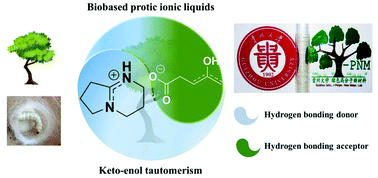Co-dissolution of cellulose and silk fibroin in levulinic acid-derived protic ionic liquids for composited membrane and fiber preparation†
Abstract
Facile dissolution of silk fibroin by using sustainable solvents is the first challenge to be overcome towards its value-added utilization. In this study, sustainable protic ionic liquids (PILs), which were prepared by a simple solventless neutralization reaction of 1,5-diazabicyclo [4.3.0]-5-nonene (DBN) and biomass-derived levulinic acid (Lev), were identified to have good solubility to silk fibroin at mild conditions. Furthermore, the co-dissolution of silk fibroin and cellulose was investigated, and the solute-solvent interaction was elucidated by 13C NMR spectroscopy. The findings demonstrated that the strong hydrogen bonding forming ability of [DBNH][Lev] PILs partially arose from the potential keto–enol tautomerism of levulinate and endowed it with desirable solubility of cellulose and silk fibroin. The rheological properties of cellulose/silk fibroin solutions were systematically studied, indicating that the mass feed ratio of cellulose/silk fibroin significantly affected the apparent viscosity, overlap concentration (c*), activation energy, storage modulus and loss modulus. The interaction and aggregation between cellulose and silk fibroin were further elucidated by dynamic light scattering (DLS). The solution properties provided great opportunities for regenerated cellulose/silk fibroin composited membranes and fiber preparation, and a series of composite membranes were facilely prepared by sol–gel transition using ethanol as a coagulation bath. Various techniques were employed to elucidate the corrections among the structural, morphological, thermal and mechanical properties of the composited membranes and fibers, including infrared spectroscopy (FTIR), X-ray diffraction (XRD), thermogravimetric analysis (TGA), scanning electron microscopy (SEM) and tensile tests. It was found that composited membranes (C50S50) had the best mechanical properties, with a tensile strength of 50 MPa and oxygen permeability of 0.0055 cm3 μm (m2 day atm)−1. Moreover, the composited fiber (C80S20) has desirable tensile strength of 152 MPa and an elongation at break of up to 12.8%.



 Please wait while we load your content...
Please wait while we load your content...